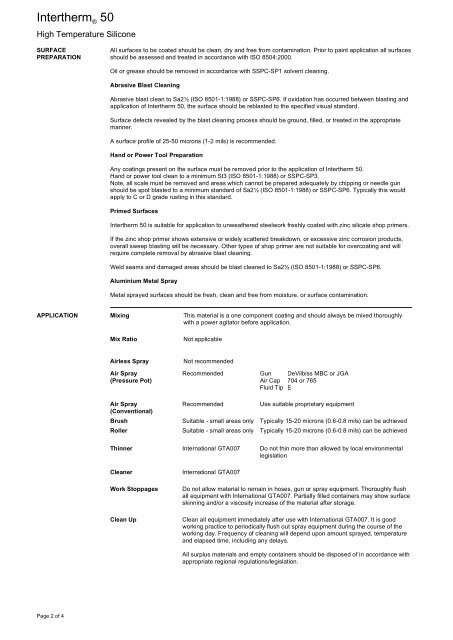English (United Kingdom) - Paul Wurth
English (United Kingdom) - Paul Wurth
English (United Kingdom) - Paul Wurth
- TAGS
- wurth
- www.paulwurth.com
Create successful ePaper yourself
Turn your PDF publications into a flip-book with our unique Google optimized e-Paper software.
Intertherm ® 50<br />
High Temperature Silicone<br />
SURFACE<br />
PREPARATION<br />
APPLICATION Mixing<br />
Page 2 of 4<br />
All surfaces to be coated should be clean, dry and free from contamination. Prior to paint application all surfaces<br />
should be assessed and treated in accordance with ISO 8504:2000.<br />
Oil or grease should be removed in accordance with SSPC-SP1 solvent cleaning.<br />
Abrasive Blast Cleaning<br />
Abrasive blast clean to Sa2½ (ISO 8501-1:1988) or SSPC-SP6. If oxidation has occurred between blasting and<br />
application of Intertherm 50, the surface should be reblasted to the specified visual standard.<br />
Surface defects revealed by the blast cleaning process should be ground, filled, or treated in the appropriate<br />
manner.<br />
A surface profile of 25-50 microns (1-2 mils) is recommended.<br />
Hand or Power Tool Preparation<br />
Any coatings present on the surface must be removed prior to the application of Intertherm 50.<br />
Hand or power tool clean to a minimum St3 (ISO 8501-1:1988) or SSPC-SP3.<br />
Note, all scale must be removed and areas which cannot be prepared adequately by chipping or needle gun<br />
should be spot blasted to a minimum standard of Sa2½ (ISO 8501-1:1988) or SSPC-SP6. Typically this would<br />
apply to C or D grade rusting in this standard.<br />
Primed Surfaces<br />
Intertherm 50 is suitable for application to unweathered steelwork freshly coated with zinc silicate shop primers.<br />
If the zinc shop primer shows extensive or widely scattered breakdown, or excessive zinc corrosion products,<br />
overall sweep blasting will be necessary. Other types of shop primer are not suitable for overcoating and will<br />
require complete removal by abrasive blast cleaning.<br />
Weld seams and damaged areas should be blast cleaned to Sa2½ (ISO 8501-1:1988) or SSPC-SP6.<br />
Aluminium Metal Spray<br />
Metal sprayed surfaces should be fresh, clean and free from moisture, or surface contamination.<br />
Mix Ratio<br />
Airless Spray<br />
Air Spray<br />
(Pressure Pot)<br />
Air Spray<br />
(Conventional)<br />
Brush<br />
Roller<br />
Thinner<br />
Cleaner<br />
Work Stoppages<br />
Clean Up<br />
This material is a one component coating and should always be mixed thoroughly<br />
with a power agitator before application.<br />
Not applicable<br />
Not recommended<br />
Recommended Gun DeVilbiss MBC or JGA<br />
Air Cap 704 or 765<br />
Fluid Tip E<br />
Recommended Use suitable proprietary equipment<br />
Suitable - small areas only Typically 15-20 microns (0.6-0.8 mils) can be achieved<br />
Suitable - small areas only Typically 15-20 microns (0.6-0.8 mils) can be achieved<br />
International GTA007<br />
International GTA007<br />
Do not thin more than allowed by local environmental<br />
legislation<br />
Do not allow material to remain in hoses, gun or spray equipment. Thoroughly flush<br />
all equipment with International GTA007. Partially filled containers may show surface<br />
skinning and/or a viscosity increase of the material after storage.<br />
Clean all equipment immediately after use with International GTA007. It is good<br />
working practice to periodically flush out spray equipment during the course of the<br />
working day. Frequency of cleaning will depend upon amount sprayed, temperature<br />
and elapsed time, including any delays.<br />
All surplus materials and empty containers should be disposed of in accordance with<br />
appropriate regional regulations/legislation.




